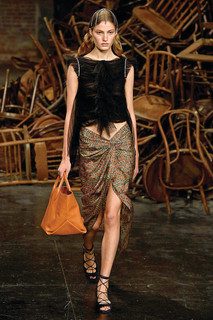More than a Runway Show at NYFW
- The Impression
- Sep 26, 2019
- 2 min read
Officially, by edict of the CFDA, New York Fashion Week closed Wednesday with Marc Jacobs’ show. But since no one is the boss of fashion week, just like no one’s the boss of an unruly 3-year old, designers kept showing and fashionistas kept trekking to see collections well into Sunday, the day “the people” decided would be the close of New York Fashion Week.
Whether it was high profilers like Jacobs and Tom Ford or strivers like Hope Wade and Ikaikai’s Dominque Bones-Lark, designers grappled with how to connect with a changing consumer. Shoppers are inordinately interested in two things: social issues and buying clothes when the need hits them. Shows are a necessary part of the creative process. And this isn’t only for designers. Stylists, photographers, editors – all the industry’s creatives get ideas from a show. Even a bad show can inspire. With the rise of Instagram invitations to runway shows, the sphere of influence has now widened to the actual consumer. Designers such as Pyer Moss and The Blondes posted their runway shows’ locations on IG and created a mob scene in Brooklyn and Manhattan, respectively, for shows that would influence not only fashion trends, but culture. The shows were a visual and aural lesson in tolerance. Tommy Hilfiger also served culture at the Apollo Theatre and Rihanna put on what could only be called an entertainment event that bled feminism. Carmelo Anthony complemented his Melo Made presentation with a live installation of a painting by South African Artist, Nelson Makamo. Indeed, one of the unifying themes was political or cultural moments. Another unifying theme was sleeveless jackets at Tibi, Dion Lee, Zero + Maria Cornejo and exaggerated collars at Tory Burch, Chocheng and Marc Jacobs set the pace. Dennis Basso, Collina strada and Khaite used embellishments like fringe, sequins or rhinestones. Relaxed silhouettes were popular and made surprise appearances at Tom Ford and Brandon Maxwell. Polka dots were everywhere (Elie Tahari, Kate Spade, Tory Burch, Carolina Herrera). Proenza Schouler and The Row drew maximum sophistication from their plays on black and white and several designers dabbled in shades of chrysanthemum red (Tahari, Coach, Michael Kors) sunny yellow (noted at Marc Jacobs, Coach 1941, and Pyer Moss) and acid green (Aliette by Jason Rembert). However, this is not just about the clothes. It is about the experience. Seeing Drake in concert or experiencing an all-female mosh pit at a Rico Nasty show is not the same as watching it in your friend’s Instagram story. A work of art in close proximity, be it clothes, music, or a painting, affects the five senses in ways the virtual world does not. It’s not that one is better than the other, but the latter is a distinct experiential event, which you share with all who are in attendance. You read each other’s facial expressions and body language and ask silently, “Do you and I feel the same way about what is coming down the runway?”























代发外链 提权重点击找我;
游戏推广 游戏推广;
Fortune Tiger Fortune Tiger;
Fortune Tiger Slots Fortune…
谷歌马甲包/ 谷歌马甲包;
谷歌霸屏 谷歌霸屏;
מכונות ETPU מכונות ETPU;
;ماكينات اي تي بي…
آلات إي بي بي…
ETPU maşınları ETPU maşınları;
ETPUマシン ETPUマシン;
ETPU 기계 ETPU 기계;
代发外链 提权重点击找我;
游戏推广 游戏推广;
Fortune Tiger Fortune Tiger;
Fortune Tiger Slots Fortune…
谷歌马甲包/ 谷歌马甲包;
谷歌霸屏 谷歌霸屏;
מכונות ETPU מכונות ETPU;
;ماكينات اي تي بي…
آلات إي بي بي…
ETPU maşınları ETPU maşınları;
ETPUマシン ETPUマシン;
ETPU 기계 ETPU 기계;
google 优化 seo技术+jingcheng-seo.com+秒收录;
Fortune Tiger Fortune Tiger;
Fortune Tiger Fortune Tiger;
Fortune Tiger Fortune Tiger;
Fortune Tiger Slots Fortune…
站群/ 站群
gamesimes gamesimes;
03topgame 03topgame
EPS Machine EPS Cutting…
EPS Machine EPS and…
EPP Machine EPP Shape…
Fortune Tiger Fortune Tiger;
EPS Machine EPS and…
betwin betwin;
777 777;
slots slots;
Fortune Tiger Fortune Tiger;
google seo…
03topgame 03topgame;
gamesimes gamesimes;
Fortune Tiger…
Fortune Tiger…
Fortune Tiger…
EPS Machine…
EPS Machine…
seo seo;
betwin betwin;
777 777;
slots slots;
Fortune Tiger…
seo优化 SEO优化;
bet bet;
谷歌seo推广 游戏出海seo,引流,快排,蜘蛛池租售;
Fortune Tiger Fortune Tiger;
Fortune Tiger Fortune Tiger;
Fortune Tiger Fortune Tiger;
Fortune Tiger Fortune Tiger;
Fortune Tiger Slots Fortune Tiger Slots;